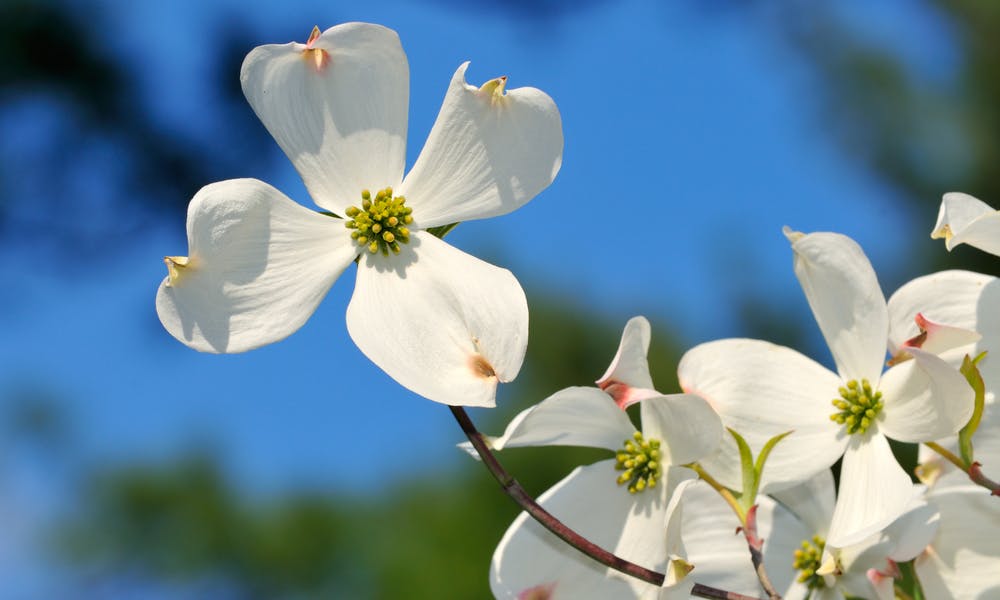MENU
The Dogwood Flower

A member of the genus Cornus, the dogwood flower, once known as the dog-tree until its name change in 1614, is generally found on deciduous trees or shrubs. A popular tree in landscaping circles, this plant is quite well known for showing off its beautiful, flashy flowers throughout the spring season up until it drops its leaves in the fall when they have turned a deep, lovely red. Thomas Jefferson himself was known to plant these gorgeous flowers in his private garden. Let us see what drew his interest!
Keep reading to find out the:
- Origins of the dogwood flower
- Dogwood looks
- The dogwood in culture
- Some fun facts
- Food knowledge
- Medicinal uses
- How to raise your own
Origins of the Dogwood Flower
The family Cornaceae, more known by its name the dogwood, is one of around 60 species of plant found throughout the world, with many being found in China, Japan and other parts of Eurasia, as well as throughout much of North America. Some of the more common species are the bloody dogwood of Eurasia, the flowering dogwood of North America, and the bunchberry, which is mainly found in Europe. The trees have been around for thousands of years, stemming back from before Christian times.
Dogwood Looks
Most dogwood flowers are separated into four pieces. The flowers tend to be in dense, open clusters although tighter clusters can be found in some of the species like the flowering dogwood. The leaves are untoothed, generally 2-5 inches in diameter with a unique curving pattern of veins to them. Many of the dogwood species have opposite leaves, but a few can be found with alternate leaves. The trees can grow from 10 to 25 feet tall, with a diameter of up to 12 inches. They can grow very quickly, reaching full height in less than a decade in some instances. The bracts, similar to petals, are modified leaves that surround a cluster of about 20 flowers and are generally a distinct white color, but pink and red such as the Rubra can be seen as well.
The Dogwood in Culture
The American states of North Carolina and Virginia both call the dogwood their national flower. It is also the official flower of the province of British Colombia in Canada. The dogwood has become symbolically associated with certain virtues such as strength, durability, purity, and toughness. The perfect flower to gift to those going through some rough times in their life and need support, or simply as a gift to yourself.
Some Fun Facts
The dogwood flower has held special significance for centuries within the Christian religion as Jesus was crucified upon a cross made from the dogwood tree. Legend holds that the trees once grew tall and straight but have been crooked and small ever since. Because of this, the tree has been used in a host of ceremonies and religious gatherings. It was also used in Victorian times as a way for a man to see if a woman was interested in him. He would offer a sprig of the tree to the woman and if her feelings for him were mutual she would keep it; else she would return it to him as a rejection of his proposal of love. This led to its symbolizing love and affection.
Food Knowledge
The flowering dogwood is one of the more common dogwood trees, and the berries it produces are quite bitter and not ideal as a food source. On the other hand, the kousa dogwood berries are quite edible, they exist in abundance in nature and are some of the most common wild berries used for food. Another species, the cornelian cherry dogwood, bears edible fruit as well, and are used in syrups and jams.
Medicinal Uses
The bark of the dogwood flower tree has been used in traditional medicine for quite some time, having been used by soldiers to treat fevers, aches, and pains as well as to cover wounds. A tea made from the roots and flowers was also used to treat malaria and diarrhea, although a tincture was sometimes used in its stead. The twigs were often chewed to help clean teeth, and the berries were soaked alongside brandy to aid with indigestion and sores.
How to Raise Your Own
Dogwoods are quite flexible and can be raised in full sunlight or partial shade, although they tend to grow more easily in shaded areas. They generally tend to be close by other taller tree species, so when choosing a location keep that in mind. They perform best in slightly acidic soil, rich in humus and organic matter. The trees can usually grow in most climates, but well-drained soil is preferable. They need daily watering during the initial planting, followed by weekly watering once they have settled in a bit. Also adding a nice layer of mulch a few inches away from the trunk of the tree helps greatly. The trees are quite sturdy and rarely need pruning, but it is always a good idea to trim dead branches and check for any infestations from time to time.
Making the Right Choice
For those looking to add some life to their back or front yards, the dogwood tree, with its lovely flowers that bloom in early spring and gorgeous foliage available all year round is a wonderful companion to have. Its smaller size and ability to grow well alongside other species of tree is ideal for those hoping to add to an existing stand of trees or start a new one. Anyone looking to have some tasty fruit to eat fresh from the tree can enjoy the more edible species such as the kousa dogwood. All in all, you can never go wrong with a dogwood.

